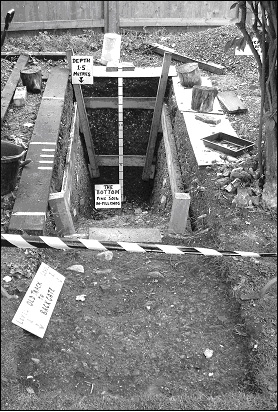
Backgarden Archaeology
By Mike & Kate Pratt
previous article | up | next article
... continued from page 3 ...
The Iron Age Dawns!
Just when it seemed that the pottery we had found in our second test pit in 2003 couldn’t be assigned to a definite era there was a breakthrough. In February of 2004 the Local History Group had a talk from an archaeologist and afterwards she looked at pieces of the pottery in question. Singling out one distinctive rim sherd she identified it as being from the Late Iron Age. This was encouraging not just because it pushed the date back but because it came from someone who specialised in the Iron Age and who had seen examples of similar pottery.
Trench 1, 2004
As soon as the weather improved sufficiently in 2004, a trench was opened up measuring 4 metres by 1 metre about 2 metres further down the garden from Test Pit 2. This represented a lot of earth moving but it was necessary in order to find the side of the “ditch” feature and have enough room to take the dig down below 1.2 metres without fear of the sides collapsing.
At Layer 5 it became clear that we had struck the edge of the same feature – proving that it was more than a pit!
We managed to get down to 1.5 metres before hitting a bottom beyond which no further finds seemed likely.

The trench at 1.5 metres deep, 2004
As well as more examples of the coarse ware, two very different finer types of pottery emerged which promised to help with the dating as they looked as though they might fall into recognisable categories. We needed someone who could identify and date these new finds and confirm the provisional dating of the coarse ware. The PAS experts consulted in York had suggested we get in touch with a local expert, an archaeologist with long experience of excavations in Yorkshire. This we did and he agreed to pay us a visit.
As well as confirming the Late Iron Age date for the coarse ware, he identified the finer types as red and grey ware of the Roman period, circa 200 to 400 AD.
Summary
Overall, the pottery found and its relative positioning in the layers of the trench suggest a feature, whether ditch or hollow, that was dug and gradually filled in during the Late Iron Age and into the Roman period. As a record of the spread of Romanisation, finer wares appear while the apparent use of the coarser wares continues alongside and possibly after them. To read Mike's Archaeology Blog click here
Page 4 of 4
(c) Copyright 2009 Contributors. All rights reserved. |
